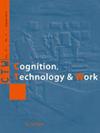Effects of worksite exercise intervention (prodet®) on well-being at work and capability in performing work-related sedentary tasks: A pilot study.
IF 3.4
3区 工程技术
Q2 ENGINEERING, INDUSTRIAL
引用次数: 0
Abstract
BACKGROUND Companies have tried to carry out interventions in order to mitigate the risks associated with losses in productivity and the health of employees. OBJECTIVE This intervention trial evaluated the effect of a supervised exercise intervention based on aerobic capacity and strength on well-being at work and capability in performing work tasks. METHODOLOGY The sample was composed of 67 participants (N = 67, mean age 34.31 years) and investigated a 12-week group physical exercise program in the workplace, two days per week for 50 minutes, which was supervised and based on aerobic endurance and strength. The 67 subjects were working-age office workers, deemed sedentary and randomized into an intervention (N = 40) or control (N = 27) group. Among them, 33 were men (N = 33; 49.25%) and 34 were women (N = 34, 50.75%). Outcomes were assessed pre- and post-test in both groups. The Mann-Whitney U and Chi-Square tests were performed to compare the characteristics of the intervention and control group. η2 = z/(n-1) was calculated as effect size rates. RESULTS The program showed statistically significant effects on strength endurance (P = 0.020, η2 = 0.08), the loss of fat percentage (P = 0.015, η2 = 0.09), lower limb power (P = 0.020, η2 = 0.08) and QoL (P = 0.0001, η2 = 0.39 for the physical health outcome, and P = 0.0001, η2 = 0.35 for the outcome of total scores of mental health). CONCLUSIONS The intervention had an impact on the endurance, fat percentage loss and QoL of the workers whose occupations were based on sedentary tasks.工作场所运动干预(prodet®)对工作幸福感和执行工作相关久坐任务能力的影响:一项试点研究。
背景:公司试图采取干预措施,以减轻与生产力损失和雇员健康有关的风险。目的:本干预试验评估基于有氧能力和力量的监督运动干预对工作幸福感和执行工作任务能力的影响。方法选取67名参与者(N = 67,平均年龄34.31岁),在工作场所进行为期12周的集体体育锻炼,每周2天,每次50分钟,在有氧耐力和力量的监督下进行。这67名受试者是处于工作年龄的办公室职员,被认为久坐不动,随机分为干预组(N = 40)和对照组(N = 27)。其中男性33例(N = 33;49.25%),女性34例(N = 34, 50.75%)。评估两组患者测试前和测试后的结果。采用Mann-Whitney U检验和卡方检验比较干预组和对照组的特征。η2 = z/(n-1)作为效应大小率。结果该方案对体力耐力(P = 0.020, η2 = 0.08)、减脂率(P = 0.015, η2 = 0.09)、下肢力量(P = 0.020, η2 = 0.08)、生活质量(生理健康结局P = 0.0001, η2 = 0.39)、心理健康总分结局P = 0.0001, η2 = 0.35)均有统计学意义。结论干预对久坐型工人的耐力、减脂率和生活质量均有影响。
本文章由计算机程序翻译,如有差异,请以英文原文为准。
求助全文
约1分钟内获得全文
求助全文
来源期刊

Cognition Technology & Work
ENGINEERING, INDUSTRIAL-
CiteScore
6.90
自引率
7.70%
发文量
26
审稿时长
>12 weeks
期刊介绍:
Cognition, Technology & Work focuses on the practical issues of human interaction with technology within the context of work and, in particular, how human cognition affects, and is affected by, work and working conditions.
The aim is to publish research that normally resides on the borderline between people, technology, and organisations. Including how people use information technology, how experience and expertise develop through work, and how incidents and accidents are due to the interaction between individual, technical and organisational factors.
The target is thus the study of people at work from a cognitive systems engineering and socio-technical systems perspective.
The most relevant working contexts of interest to CTW are those where the impact of modern technologies on people at work is particularly important for the users involved as well as for the effects on the environment and plants. Modern society has come to depend on the safe and efficient functioning of a multitude of technological systems as diverse as industrial production, transportation, communication, supply of energy, information and materials, health and finance.
 求助内容:
求助内容: 应助结果提醒方式:
应助结果提醒方式:


